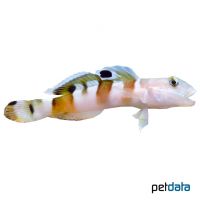Ward’s Sleeper Goby (Valenciennea wardii)
| Ward’s Sleeper Goby Valenciennea wardii | |
|---|---|
| Name | Ward’s Sleeper Goby |
| Name Lat. | Valenciennea wardii |
| Family | Gobies |
| Family lat. | Gobiidae |
| Order | Gobies |
| Order lat. | Gobiiformes |
| Origin | Indo-West Pacific, Red Sea |
| Habitat | Sandy areas, reefs |
| Diet | Carnivore |
| pH | 8.1-8.4 |
| Hardness | 8-10 °KH |
| Behavior | Peaceful |
| Keeping | Pair |
| Reef Compatible | Yes |
| Care Level | Moderate |
| Life Span | 5-8 years |
| Protection | No |
| Metric Units | |
| Size | 11 cm |
| Temperature | 24-28 °C |
| Salinity | 33-36 ‰ |
| Aquarium | ~ 250 l |
| US Units | |
| Size | 4" |
| Temperature | 75-82 °F |
| Salinity | 1.020-1.025 sg |
| Aquarium | ~ 65 gal |
Distribution and habitat
Valenciennea wardii have a wide range, extending from the Red Sea throughout the tropical Indian Ocean to the western Pacific. They always live in pairs in the sandy zones of shallow reefs protected from strong surf down to 15 m depth.
Maintenance
They need a well structured aquarium with a reef structure that allows for territoriality (crevices, caves, shelters), with live stones that act like a biological filter and a fine substrate at least 6 cm deep (no coral rubble!). Only lime-rich, heavy metal-free sands, gravels, stones or sea sand of various grain sizes may be used as substrate
To ensure water quality, filters, skimmers and heaters are necessary, as well as pumps to simulate tides, swells and bottom currents. Lighting must correspond to the species-appropriate day-night rhythm of the animals
| Salinity: 33-36 ‰ | pH value: 8.1-8.4 |
| Carbonate hardness: 8-10 °KH | Nitrate content: 2-8 mg/l |
| phosphate content: 0.01-0.1 mg/l | nitrite content: 0.0-0.05 mg/l |
For salinity, an average value should be aimed for, which may only vary slightly by +/- 0.5 ‰. Ammonia and ammonium must not be measurable. Special attention must be paid to constantly good water quality.
Diet
In nature, they feed mainly on small organisms found in the soil (crustaceans, worms, etc.). The food change usually succeeds without problems. The food supply should consist of a combination of live and frozen food, such as small mysis, artemia, bosmids, mosquito larvae and cyclops, with chopped shrimp, fish and mussel meat or a commercial frozen food mix enriched with vitamins. Dry food (tablets, granules) is occasionally accepted after an acclimation period
It is recommended to feed small portions several times a day. Regular and varied feeding promotes health and increases resistance.
Behaviour and compatibility
They are territorial and strictly monogamous. Animals kept singly usually do not survive long, therefore they should only be kept in pairs. Keeping several pairs of different sleeper gobies is only recommended in a larger and richly structured tank. Towards other fish they behave peacefully, whereby too small fish are considered as food.
Sex dimorphism
The male is slightly larger and has elongated fin rays on the first dorsal fin.
Reproduction and breeding
The eggs are pinned to the cave ceiling and cared for by the female. After 2-3 weeks the fry leave the cave. The fry must be fed several times a day with special rearing food (e.g. plankton, rotifers).
Important
Due to the special form of feeding, they sift the sand for small creatures, the substrate is always kept clean. However, shells and corals can be damaged by sand deposits.
At night or in case of danger they retreat into self-dug caves under stones or coral blocks, accordingly the reef construction must be well secured.
As coral reef dwellers, they should not be maintained in a fish-only aquarium
If different species are kept together, care should be taken to ensure that the fish match each other in terms of water quality and temperature requirements and social behavior, and that the setup meets the needs of all species kept together. New fish to be introduced must be acclimated slowly to the water in the aquarium
Further literature can be found in your pet store.
References
Text: Werner Winter; Image: petdata
Source: BAENSCH & DEBELIUS (2006): Meerwasser Atlas Bd. 1, Mergus Verlag; ENGELMANN (2005): Zootierhaltung - Tiere in menschlicher Obhut: Fische, Verlag Harri Deutsch
- Gemäß § 21 Abs. 5 Tierschutzgesetz idgF
